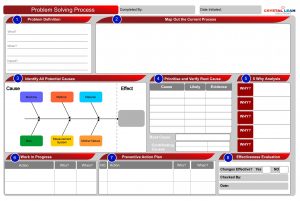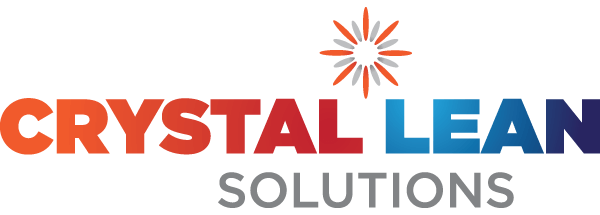The Importance of 6S – 5s plus Safety
6S is a foundational element for Lean deployment and focuses on creating and maintaining an organised working environment. It helps businesses promote efficiency and establishes a sustainable culture of safety throughout a workplace.
With its origins in Toyota, Japan, 6S is the entry point for introducing visual management and control in the workplace. To understand the importance of 6S, an elaboration of what each “S” represents on the journey towards an organised workplace is critical. The 6S principles are:

- Sort
- Straighten
- Shine
- Standardise
- Sustain
- Safety
Each principle is described further here as follows:
Sort (Seiri)
This is the initial stage in the 6S methodology and aims to reduce clutter, making it easier for essential work items to be located for improved efficiency. “Red tagging” is often done to mark unnecessary items for immediate disposal, while “yellow tagging” can be applied for those items that can be temporarily stored offsite.
Straighten (Seiton)
In the next stage of the 6S system, the items that are identified as essential in the Sort stage are placed in an organised manner in the most logical locations. Items that are frequently used are located nearest the user and less frequently used items are stored further away.
The objective of this step is to establish a systematic way of storing and retrieving items, helping to maximise accessibility, efficiency and space. Shadow boards, labelling and signage would be examples of what is introduced at this stage.
Shine (Seiso)
After non-essential items have been removed and essential items have been organised, the next step is cleaning. The third stage of the 6S lean system, also known as ‘Shine’, includes activities, such as cleaning the workplace, maintaining its pleasant appearance, and using preventive steps to keep workspaces tidy and clean.
Cleaning products are also stored similar to items in the previous step. A standard cleaning process is agreed. The objective is to create an environment that is organised and clean so that anomalies can easily be spotted (such as leaks on machines or items being out of place).
Standardise (Seiketsu)
‘Standardise’ aims to establish a new routine by identifying best practices and creating consistent procedures. This can be done to support teams through visual reminders, setting expectations of workers’ responsibility. Standardisation can include standard noticeboards with metrics, colour coding of the working area, standardised signage and labelling, standardised process for cleaning an area. ‘What gets measured gets managed’ and by completing checks and reporting, robust routines can be established.
Sustain (Shitsuke)
This aspect is the most challenging of the 6S process as it involves embedding the procedures to ensure they become a routine part of day-to-day operations. Companies typically introduce 6S assessments to ensure the 6S standards are maintained. Leader Gemba walks also positively reinforce the importance of 6S as a cultural foundation of a Lean culture.
Safety
The 6S process features Safety as the final step, this was added to the original standard 5S methodology with which long-standing practitioners of lean have grown familiar. This essential step of 6 S focuses on proactively identifying safety risks and setting preventive controls to keep everyone safe during work. In this way we can ensure that the environment meets safety standards at a minimum.
It is also layered into the previous steps, to ensure that an area is laid out ergonomically, that slip, trip and fall hazards are minimised or mitigated and that the assessment system includes safety metrics as an integral part of workplace organisational practices.


Considerations for 6S Deployment:
When an organisation embarks on a 6S journey, many start with great enthusiasm and yet find after a few months that “6S didn’t work”. Generally, it’s not that it didn’t work, but actually wasn’t planned for success. Sustaining a 6S programme is a cultural shift and requires:
- Leadership buy-in and resourcing the programme beyond initial signage and labelling
- A clear understanding of what is the strategic driver for the programme
- A change management approach
- Communication programme including “What’s in it for me?”
- Project team to launch and manage the programme and then manage the long-term success with a view to transitioning the practice into the DNA of daily work
- Education on 6S
- Process to manage sustainability of the programme (metrics and continuous improvement)
- Benchmarking
Consider Effectiveness v Efficiency
Efficiency: At its simplest, 6S reduces search time for materials or tools. This alone has a very positive impact on a number of the 8 wastes and will improve productivity very quickly.
Quality: The next level is that if an organisation gets 6S right, quality issues will be obvious immediately, this ensures that people can react quickly to contain quality problems.
Safety: The third level is that of safety; reducing the opportunity of
slips, trips and falls is a key outcome of a 6S programme.
People: Finally, when 6S works well, the workplace is a much more pleasant place to work. It’s a well-lit area, with good space to move around and anything you need to do your work is at hand.
In Summary
It is as important to be effective as efficient as an organisation. Focus does not always have to be minimising labour.
6S is a foundational process in Visual Management. It creates a workplace standard that provides an excellent foundation to a continuous improvement culture. The system delivers benefits in terms of efficiency, quality improvement, safety in particular minimising slips, trips and falls and has a positive impact workers wellbeing.
6S is a 6-step process, originally from Toyota in Japan, with a focus on workplace organisation.
Make a conscious decision to commit to 6S – Similar to any programme being introduced into a business, be clear on “Why” the programme is being introduced and then commit to this decision.
And Finally, some Top Tips:
- Change Management Framework – This is some level of change in the organisation, so use a change management framework.
- Benchmark – Go see what other companies across different sectors are doing and learn from their
 experiences.
experiences.- Project Management – Resource 6S deployment and involve everyone that is working in each area to decide their own requirements, aligned to agreed standards
- Provide Training – Provide appropriate levels of training to Leaders, Project Team and people in the areas
- Be Action orientated – Pilot an area before full deployment and align to the overall Lean/ Continuous Improvement strategy
- Engage Teams – 6S is for everyone in the business and should involve everyone throughout the deployment and sustainment programme
- Get Help – for initial pilot, include a team with change management experience to support.
How CLS (Crystal Lean Solutions) can help
We offer a range of training programmes both with support and consultancy to help organisations in their deployment of Lean. Our supports include:
- Mentoring of 6S programme across the business (from Project Charter to Sustainment programme)
- 6S Training programmes
- Facilitation of onsite 6S workshops
- Change Management mentoring/consultancy approach to maximise long term success
- 6S Project Manager
- Notice Board Design
- Develop “Metrics that Matter” for the organisation
- Training and Mentoring on Full Visual Management Suite
